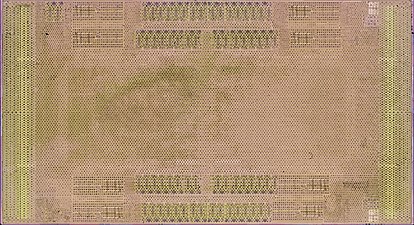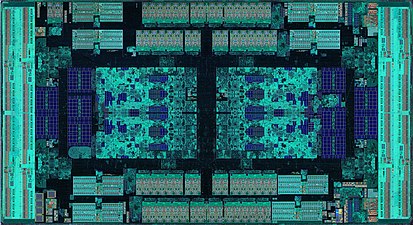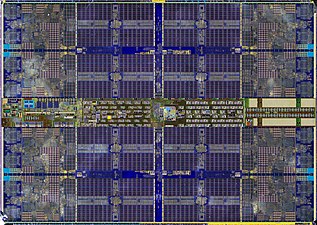Decapping
This article needs additional citations for verification. (November 2020) |
Decapping (decapsulation) or delidding of an integrated circuit is the process of removing the protective cover or integrated heat spreader (IHS) of an integrated circuit so that the contained die is revealed for visual inspection of the micro circuitry imprinted on the die. This process is typically done in order to debug a manufacturing problem with the chip, or possibly to copy information from the device,[1] to check for counterfeit chips or to reverse engineer it.[2][3] Companies such as TechInsights[4] and ChipRebel[5] decap, take die shots of, and reverse engineer chips for customers. Modern integrated circuits can be encapsulated in plastic, ceramic, or epoxy packages.
Decapping is usually carried out by chemical etching of the covering,[2][6] laser cutting, laser evaporation of the covering,[7] plasma etching[6] or mechanical removal of the cover using a milling machine, saw blade[8] or by desoldering and cutting.[9] The process can be either destructive or non-destructive of the internal die. With care, it's possible to decap a device and still leave it functional. Delidding may also be done in an effort to reduce the operating temperatures of an integrated circuit such as a processor, by replacing the thermal interface material (TIM) between the die and the IHS with a higher-quality TIM.[10]
Chemical etching usually involves subjecting the (if made of plastic) IC package to concentrated or fuming nitric acid, heated concentrated sulfuric acid, white fuming nitric acid or a mixture of the two for some time, possibly while applying heat externally with a hot plate or hot air gun,[7][3] which dissolve the package while leaving the die intact.[11][2][6] The acids are dangerous, so protective equipment such as appropriate gloves, full face respirator with appropriate acid cartridges, a lab coat and a fume hood are required. [7]
Laser decapping scans a high power laser beam across the plastic IC package to vaporize it, while avoiding the actual silicon die.[7]
Delidding removes the IHS of an IC such as a computer processor using an oven to soften the solder (if present) between the IHS and the die(s) and cutting to cut the adhesive in the periphery of the IHS, which joins the IHS with the processor package substrate, which is often a printed circuit board. The die(s) are mounted on the substrate using flip chip.[9]

AMD Zen 2 EPYC 7702 server processor, before delidding

AMD EPYC 7702 after delidding, with remains of solder thermal interface material (TIM).

Removed and flipped over center die before metallization etching; visible are pads for flip chip solder balls

Die shot of the center die, after removal from processor package substrate and metallization etching.

Die shot of one of the 8 other dies on the processor, after metallization etching.

Copper interconnect (metallization) etching (removal) steps
See also[]
- Reverse engineering
- Sample preparation equipment
References[]
- ^ "MAME devs are cracking open arcade chips to get around DRM – Ars Technica". arstechnica.com.
- ^ a b c "How to crack open some computer chips and take your own die shots - ExtremeTech". www.extremetech.com.
- ^ a b https://labs.f-secure.com/archive/dont-try-this-at-home-decapping-ics/
- ^ Frumusanu, Andrei. "TechInsights Publishes Apple A12 Die Shot: Our Take". www.anandtech.com.
- ^ Frumusanu, Andrei. "ChipRebel Releases Exynos 9820 Die Shot: M4 CPUs in New Cluster". www.anandtech.com.
- ^ a b c https://www.semitracks.com/reference-material/failure-and-yield-analysis/failure-analysis-package-level/delid-and-decap.php
- ^ a b c d "decap:epoxy [Silicon Pr0n]". siliconpr0n.org.
- ^ "555 timer teardown: inside the world's most popular IC".
- ^ a b "AMD Ryzen Threadripper 3960X Delidded, Tested With Direct-Die Cooling". December 17, 2019.
- ^ https://www.pcgamer.com/delidding-your-cpu-is-scary-but-worth-itand-surprisingly-easy/#:~:text=Delidding%20is%20the%20act%20of,%2C%20and%20voila%3A%20lower%20temperatures.
- ^ "Learn IC Decapping". October 21, 2020.
- Integrated circuits
- Electronics stubs
- Technology stubs



